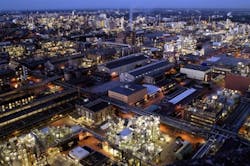The push for more-proactive maintenance at plants is getting a big boost from more-extensive condition monitoring. Increasing capabilities and lower costs to capture critical data, as well as advances in data analytics, underpin the growing use and power of such monitoring.
The overall goal of the chemical industry is “no surprises,” notes Doug Child, director, U.S. chemical industry, Siemens Industry, Inc., Buffalo Grove, Ill. “That means less downtime, no unplanned shutdowns and the highest possible availability of the production systems.”
Integrated condition monitoring can play a crucial role in achieving this goal. So, vendors like Siemens have bolstered their portfolios of intelligent field devices with capabilities for self-diagnosis as well as finely tuned instrumentation technology and smart sensors with advanced software algorithms for highly accurate continuous measurements. Coupling such devices with today’s more-powerful control systems, modern communication protocols and advances in wireless technology makes condition monitoring one of the most powerful weapons in the maintenance armory.
[callToAction ]
Meanwhile, technological advances that are part of the Internet of Things (IoT) are eliminating the data silos that exist today between condition monitoring, computerized maintenance management systems, and other disconnected systems, explains Drew Mackley, director of reliability solutions with Emerson Automation Solutions, Knoxville, Tenn. This promises substantial additional benefits, he says. “With more precise focus on the production assets that require attention, organizations will further improve the overall plant reliability.”
The industry’s conservative nature slows its adoption of innovation, though. “The chemical segment is somewhere in-between slower upstream adopters like oil and gas and faster downstream adopters like pharmaceuticals. However, we’re seeing chemical plants beginning to incorporate more-sophisticated maintenance practices and implementing the technologies to support [them],” notes Jason Hoover, director of digitalization, Siemens Large Drives, New Kensington, Pa.
A Drive For Improvement
As an example, he cites the monitoring of the numerous motors and drives at a typical process facility. “Many plants are beginning to connect these motors and drives to the IoT so that they can send valuable data that enables users to optimize production efficiency and minimize downtime. The evolution of technology, especially around big data, has certainly played a key role.”
Because both sensors and IoT data connectivity and analysis have become exponentially more powerful and cost-effective, the value of connectivity has increased very rapidly.
Hoover uses the electric motor to illustrate this point. Until recently, it only was cost effective to monitor the biggest and most critical assets. Today, for a tiny outlay a plant can install a small box on a motor that provides valuable data around motor vibration, temperature and partial discharge. This makes it cost-effective to not only monitor the biggest motors in the plant but also the low-voltage ones that still can incur high costs if they fail.
Multiple motors can communicate wirelessly to a common hub that securely sends their information to a platform —in the case of Siemens, cloud-based MindSphere IoT — where apps can assess equipment health and performance versus similar assets, and compare a motor’s “digital signature” to the one taken during the factory tests. This strategy can produce many powerful insights into the asset’s health and performance, and allows keeping all information about the asset — performance data, maintenance records, engineering drawings, operations-and-maintenance manuals, etc. — in a single repository so users easily can access the most current information.
On a broader note, having a common, integrated database for engineering, operations and maintenance enables creating a digital twin of the whole plant, Child emphasizes. This can allow recognizing disturbances and faults anywhere at an early stage, permitting maintenance services or repairs to occur before any costly breakages or downtime.
One issue that needs closer consideration is how digitalization of condition monitoring data can improve mean time to restore/repair, says Hoover. He cites the example of a power plant that managed to resolve an unplanned trip about 80% faster using data connectivity. This connectivity allowed a Siemens expert to access event and fault data and to begin diagnosis and troubleshooting immediately.
“The expert helped the plant work through two maintenance issues and get the process back up and running, leading to a real, quantifiable productivity improvement of over $120,000 in just this one instance. The ‘virtual expert’ was able to engage almost immediately after the event, even faster than if he were on site,” Hoover adds.
Child points to another important addition to the condition monitoring arsenal: the ongoing rise of intelligent apps. While Siemens has many, two particularly aim at better maintenance planning. The first allows plants to manage drives, motors and gear units all together; the second uses existing diagnostics and process data for anomaly detection in valves and then makes proposals for predictive and just-in-time maintenance.
“When you add in the connection of mobile devices, paperless order management and remote working, you get a seamless information flow between the management of an asset and the real work onsite. It completes the overall concept of digital services,” adds Child.
Decreasing sensor costs and increasing power of data services will spur even greater connection of plant floor equipment, agree both Child and Hoover. However, digitalization extends beyond the networking of devices and data, or adding digital functionality to existing products, stresses Child: “It is moreover the need to keep the chemical plant and the data state-of-the-art in a digital twin due to ongoing changes — and to use ‘as is’ instead of ‘as built’ data.”
A Shake Up
Emerson Automation Solutions, Knoxville, Tenn., has found vibration to be a major issue on recent projects.
The company has completed a project at SABIC UK Petrochemicals’ site in Wilton, U.K., that focused on improving the monitoring of critical olefin-cracker pumps. The previous system of manual vibration-data collection and analysis for the pumps couldn’t forestall potential problems that sometimes arose between readings that led to higher maintenance costs and reduced availability.
So, the SABIC olefins team opted to install a wireless condition monitoring and prediction system that included AMS 9420 wireless vibration transmitters and PeakVue machinery analysis technology.
The transmitter collects overall vibration and temperature data while the analysis package detects faults that could cause friction, impacting and fatigue — particularly in gearbox and rolling-element bearings. The monitoring system reports machinery health alerts every 30 minutes and conducts an in-depth, full-spectrum analysis once every day.
Figure 1. Data analysis after unexpected steam-turbine shutdown at Ludwigshafen site showed cause and enabled restart with only modest downtime. Source: BASF.
Since installation, the online vibration monitoring system has detected a number of problems, including a chipped tooth on a gearbox gear and an impending bearing failure, that could have resulted in equipment failure. Identifying and rectifying potential problems earlier has helped minimize pump failures and maintenance costs and has improved maintenance scheduling. The monitoring also reduces the risk of unexpected failures that can cause lost production as well as safety and environmental incidents.
Because the plant already had a smart wireless network, the installation of the wireless vibration transmitters was simple; the devices started broadcasting machinery health alerts based on the vibration readings to the distributed control system almost immediately. The same network now is simplifying the task of adding wireless-enabled condition monitoring devices in remote and difficult-to-access areas.
A Flint Hills Resources (FHR) refinery in the U.S. also had pump issues. Here, a process hazard analysis showed that the 110 pumps involved in handling 320,000 bbl/d of high-sulfur heavy crude posed high risk because their failure potentially could prompt a vapor cloud release and explosion.
The company needed an early detection method to determine when the pumps were operating in a high-risk mode. With this early detection, FHR hoped to manage the risk of pump failure, and avoid injury, process shutdown and additional maintenance expense.
Like SABIC, FHR opted for the AMS 9420 for the early detection of hazardous vibration and impacting, coupled with PeakVue.
The analysis package detects the impacting caused by rolling-element bearing faults, under-lubrication and pump cavitation — all major causes of pump failure if left unaddressed. The data are reported to the control room. When the readings cross a predetermined alert level, the facility has a procedure to address the issue within a certain timeframe. The on-site maintenance engineer also can tap into the vibration measurements provided by the vibration sensor to perform advanced diagnostics and troubleshooting.
FHR now knows which pumps must be shut down and which pumps safely can remain in operation. In its first eight months of operation, the new detection scheme has enabled the company to find and address three or four potentially hazardous situations.
Turbine Trip
Vibration also was an issue when BASF experienced an unexpected shutdown and high vibration alarm on a steam turbine train running at full load at its headquarters in Ludwigshafen, Germany (Figure 1).
The operators were unsure about what caused the shutdown and also were concerned that the machine might have been damaged and, so, might not be able to be restarted. A diagnostic and monitoring maintenance team began the failure analysis by checking distributed control system data. The only visible data showed a unit trip and high vibration alarm with no discernible cause. So, the team couldn’t determine if the machinery could be restarted safely.
BASF needed a fast recording of all channels simultaneously, with high resolution, to define the cause of the shutdown.
This type of data typically is provided when GE’s Bently Nevada 3500 machinery monitoring system is used in conjunction with its System 1 condition-monitoring software. BASF had both systems — but, in this case, the System 1 wasn’t connected to the 3500 system. However, by activating the “flight recorder” functionality of the 3500 and using a converter tool, these data were transferred into the System 1 archive, allowing a full diagnostic investigation to be carried out.
Analysis of these data showed that as the turbine slowed to 0 rpm, the compressor started driving the turbine, reversing machine operation. This, in turn, was found to stem from high pressure in the pipeline between the compressor output and a leaking back-pressure valve. The pressure was high enough to drive the compressor and turbine train backwards. The reverse rotation caused the vibrations.
However, the data showed no evidence of machine damage due to vibrations. So, following repair of the valve, the diagnostic and maintenance team recommended the turbine be restarted.
The availability and quality of the data provided allowed BASF to limit downtime to just eight hours and reduce the costs associated with the unplanned shutdown, notes GE.
Figure 2. Real-time information from multiple sites is sent from the cloud to both mobile and web app systems. Source: Pall Corp.
Fluid Focus
Pall Corporation, Port Washington, N.Y., says its new Crixus fluid monitoring platform is the first to bring fluid-cleanliness management for lube and hydraulic applications into the IoT by using a series of process sensors connected to a cloud-based predictive analytics platform. The patent-pending technology allows intelligent fluid monitoring and meets the growing need for lubrication and hydraulic fluid cleanliness, states the firm.
Crixus provides real-time data that instantly flag performance issues and warn of potential problems. Information from the cloud is pushed to the Crixus mobile and web app where systems and applications from multiple sites can be monitored (Figure 2).
The company says this is its first step toward the IoT and that the ongoing development of smart sensors also will enable it in the future to offer more-advanced filtration technologies to its industrial customers.
Meanwhile Honeywell Process Solutions, Houston, Texas, and SKF, Gothenburg, Sweden, also are putting fluids under the spotlight as part of a pilot project that aims to develop a user-friendly digital ecosystem that captures and analyzes large amounts of data from a site’s machinery. Based on the analysis of these data, plant operators then will be able to determine methods to reduce or even eliminate manufacturing inefficiencies and unplanned down-time. The hope is that combining Honeywell’s data-consolidation expertise with SKF’s lubrication and bearings condition-monitoring skills will enable better understanding and management of the risks and demands on operating units.
Seán Ottewell is Chemical Processing's Editor at Large. You can email him at [email protected].




